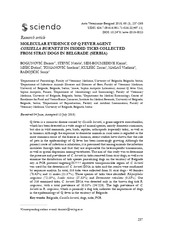Приказ основних података о документу
Molecular evidence of q fever agent coxiella burnetii in ixodid ticks collected from stray dogs in Belgrade (Serbia)
| dc.creator | Bogunović, Danica | |
| dc.creator | Stević, Nataša | |
| dc.creator | Sidi-Boumedine, Karim | |
| dc.creator | Mišić, Dušan | |
| dc.creator | Tomanović, Snežana | |
| dc.creator | Kulišić, Zoran | |
| dc.creator | Magaš, Vladimir | |
| dc.creator | Radojičić, Sonja | |
| dc.date.accessioned | 2020-06-03T14:22:48Z | |
| dc.date.available | 2020-06-03T14:22:48Z | |
| dc.date.issued | 2018 | |
| dc.identifier.issn | 0567-8315 | |
| dc.identifier.uri | https://vet-erinar.vet.bg.ac.rs/handle/123456789/1589 | |
| dc.description.abstract | Q fever is a zoonotic disease caused by Coxiella burnetii, a gram-negative coccobacillus, which has been detected in a wide range of animal species, mostly domestic ruminants, but also in wild mammals, pets, birds, reptiles, arthropods (especially ticks), as well as in humans. Although the exposure to domestic animals in rural areas is regarded as the most common cause of the disease in humans, recent studies have shown that the role of pets in the epidemiology of Q fever has been increasingly growing. Although the primary route of infection is inhalation, it is presumed that among animals the infection circulates through ticks and that they are responsible for heterospecific transmission, as well as spatial dispersion among vertebrates. The aim of this study was to determine the presence and prevalence of C. burnetii in ticks removed from stray dogs, as well as to examine the distribution of tick species parasitizing dogs on the territory of Belgrade city. A PCR protocol targeting IS1111 repetitive transposon-like region of C. burnetii was used for the detection of C. burnetii DNA in ticks and the results were confirmed by sequence analysis. In total, 316 ticks were collected from 51 stray dogs - 40 females (78.43%) and 11 males (21.57%). Three species of ticks were identified: Rhipicephalus sanguineus (72.15%), Ixodes ricinus (27.53%) and Dermacentor reticulatus (0.32%). Out of 316 examined ticks, C. burnetii DNA was detected only in the brown dog tick R. sanguineus, with a total prevalence of 10.53% (24/228). The high prevalence of C. burnetii in R. sanguineus, which is primarily a dog tick, indicates the importance of dogs in the epidemiology of Q fever in the territory of Belgrade. | en |
| dc.publisher | Univerzitet u Beogradu - Fakultet veterinarske medicine, Beograd | |
| dc.relation | info:eu-repo/grantAgreement/MESTD/Technological Development (TD or TR)/31088/RS// | |
| dc.rights | openAccess | |
| dc.source | Acta Veterinaria-Beograd | |
| dc.subject | Belgrade | en |
| dc.subject | Coxiella burnetii | en |
| dc.subject | dogs | en |
| dc.subject | ticks | en |
| dc.subject | PCR | en |
| dc.title | Molecular evidence of q fever agent coxiella burnetii in ixodid ticks collected from stray dogs in Belgrade (Serbia) | en |
| dc.type | article | |
| dc.rights.license | ARR | |
| dcterms.abstract | Сиди-Боумедине, Карим; Томановић, Снежана; Стевић, Наташа; Кулишић, Зоран; Радојичић, Соња; Мишић, Душан; Богуновић, Даница; Магаш, Владимир; | |
| dc.citation.volume | 68 | |
| dc.citation.issue | 3 | |
| dc.citation.spage | 257 | |
| dc.citation.epage | 268 | |
| dc.citation.other | 68(3): 257-268 | |
| dc.citation.rank | M23 | |
| dc.identifier.wos | 000446384500003 | |
| dc.identifier.doi | 10.2478/acve-2018-0023 | |
| dc.identifier.scopus | 2-s2.0-85056151237 | |
| dc.identifier.fulltext | https://vet-erinar.vet.bg.ac.rs/bitstream/id/551/1588.pdf | |
| dc.type.version | publishedVersion |

